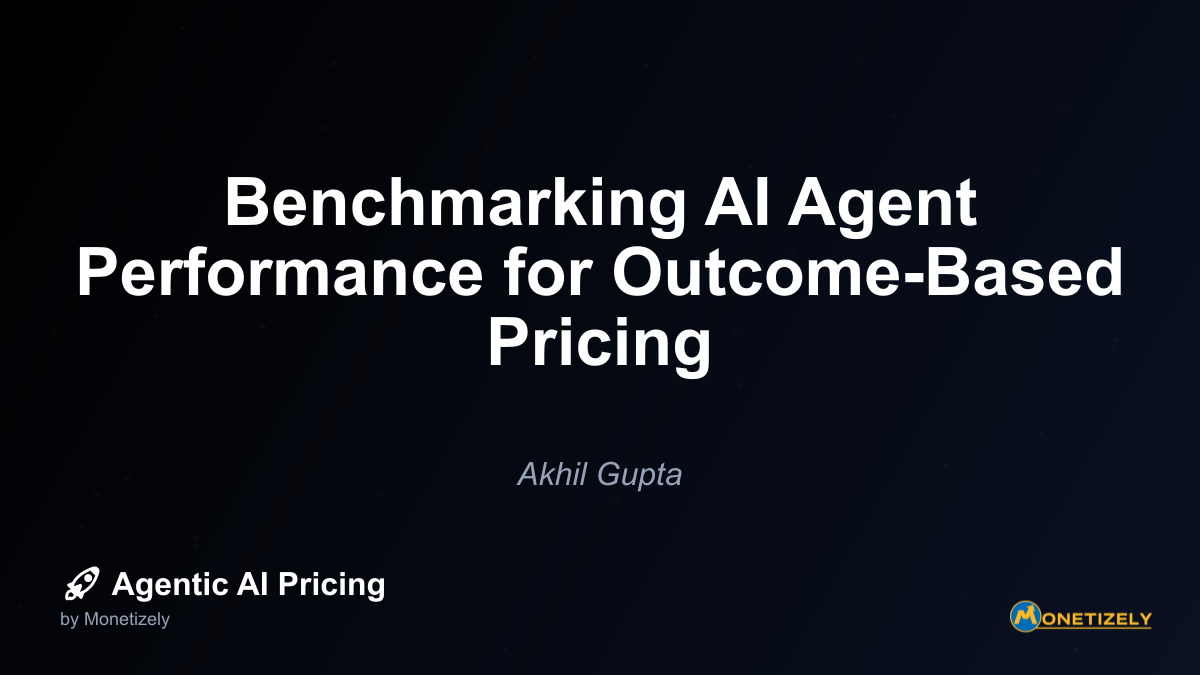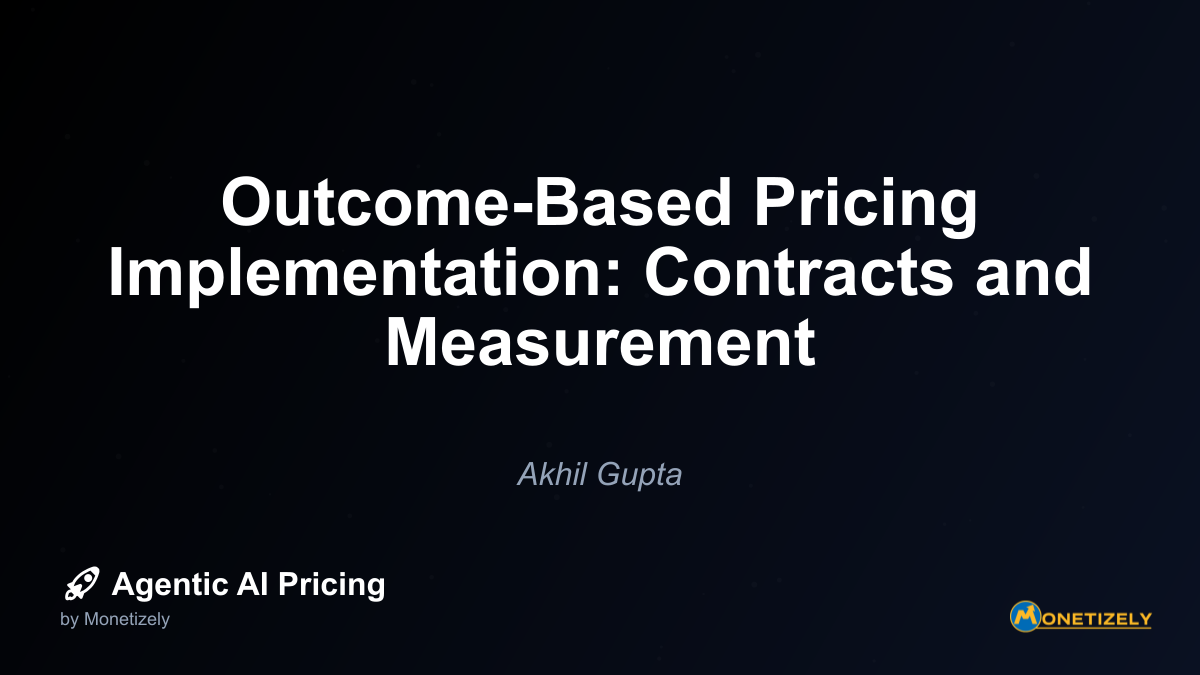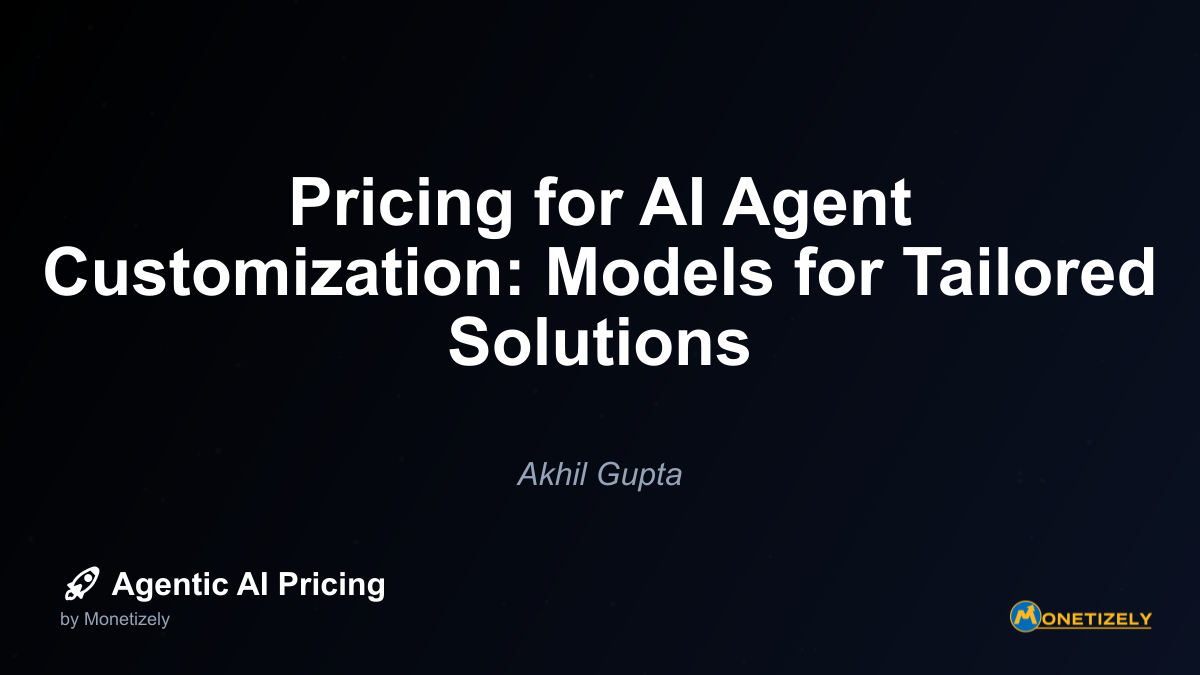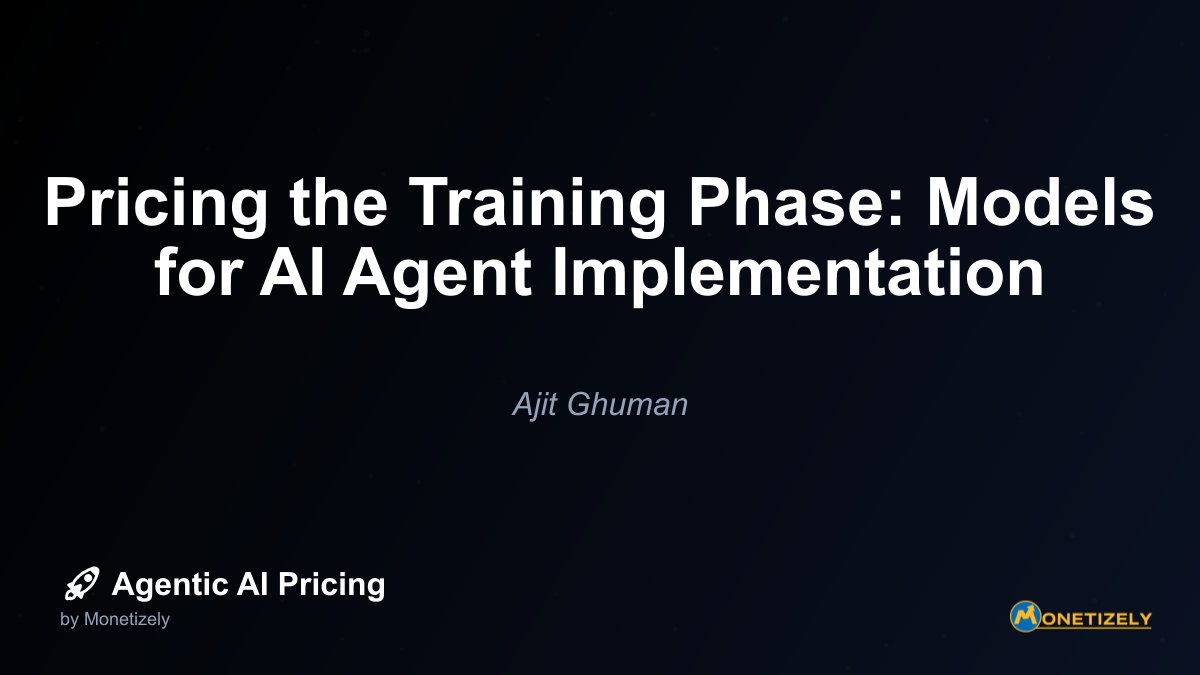· Ajit Ghuman · Implementation · 11 min read
AI Agent SLAs: Setting Performance Guarantees That Scale
AI and SaaS Pricing Masterclass
Learn the art of strategic pricing directly from industry experts. Our comprehensive course provides frameworks and methodologies for optimizing your pricing strategy in the evolving AI landscape. Earn a professional certification that can be imported directly to your LinkedIn profile.
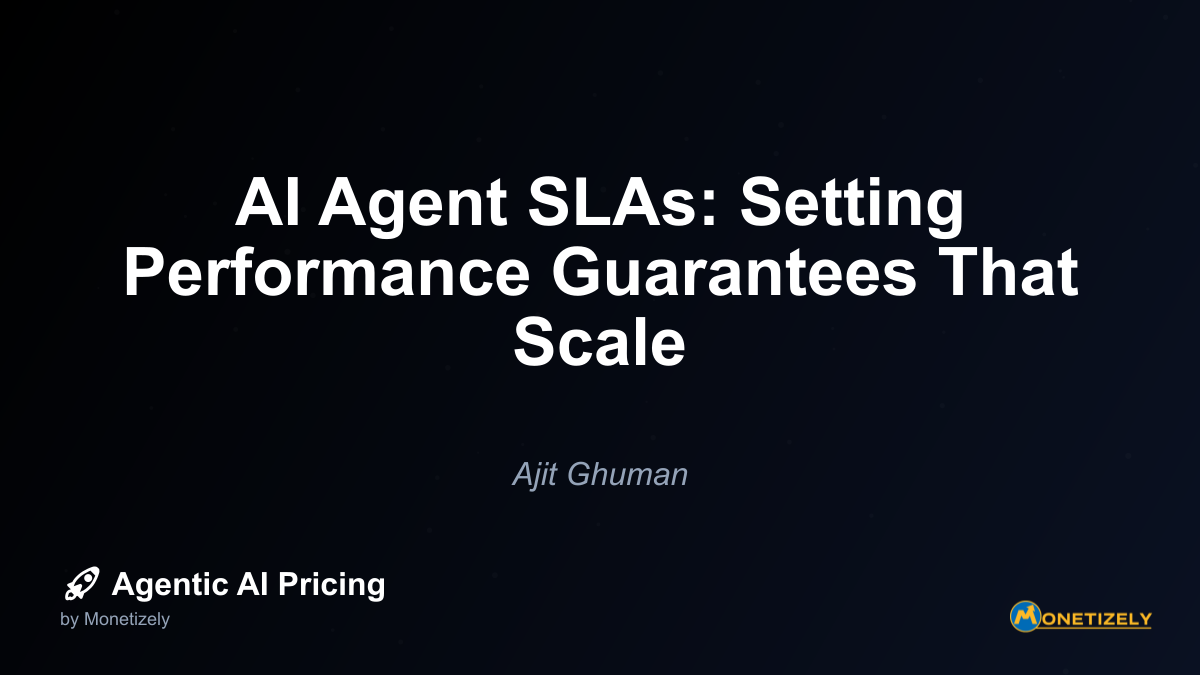
In today’s rapidly evolving AI landscape, service level agreements (SLAs) for AI agents are becoming increasingly critical as organizations move from experimental deployments to mission-critical implementations. These performance guarantees represent the formal commitment between service providers and customers, defining what constitutes acceptable AI agent performance and establishing clear expectations for both parties.
The Evolution of AI Agent SLAs
Traditional SLAs focused primarily on system availability and response times. However, AI agent SLAs must address a much broader spectrum of performance characteristics that reflect their autonomous, decision-making capabilities.
According to recent research, the AI agent market is projected to grow from $5.26 billion in 2024 to $46.58 billion by 2030, reflecting strong enterprise adoption. As organizations increasingly rely on these autonomous systems for critical business functions, the need for robust, well-defined SLAs becomes paramount.
“AI agent SLAs in 2023-2025 are transitioning to cover autonomous, multi-agent systems with complex performance and governance metrics,” notes industry research. This evolution reflects the changing nature of AI capabilities and customer expectations.
Key Components of Effective AI Agent SLAs
1. Performance Metrics Beyond Uptime
While traditional availability metrics remain important, AI agent SLAs must incorporate a more comprehensive set of performance indicators:
- Success Rate: Percentage of tasks completed without human intervention
- Precision and Recall: Critical for evaluating classification quality
- Generalization Accuracy: Ability to handle new, unseen input variations
- Response Time: Average or percentile latency in completing tasks
- Resolution Rate: Percentage of customer queries fully resolved by the AI agent
- Emotion and Sentiment Metrics: Tracking customer sentiment trajectory in support interactions
Recent industry data highlights that leading companies are moving beyond simple uptime guarantees to these more nuanced performance metrics that better reflect AI agents’ actual value delivery.
2. Tiered Service Levels
Effective AI agent SLAs typically incorporate tiered service levels that align with different customer needs and price points:
| Service Tier | Performance Guarantee | Response Time | Human Oversight | Example Use Case |
|---|---|---|---|---|
| Standard | 95% success rate | < 10 seconds | Limited | Basic automation |
| Professional | 98% success rate | < 5 seconds | Available | Business workflows |
| Enterprise | 99.5% success rate | < 2 seconds | Dedicated | Mission-critical |
Each tier represents a different balance between performance guarantees and cost, allowing organizations to select the appropriate level based on their specific requirements and budget constraints.
3. Clear Definition of Edge Cases and Exceptions
AI systems inherently face limitations and edge cases where performance may degrade. Transparent SLAs explicitly define:
- Known Limitations: Specific scenarios where the AI agent may not perform optimally
- Exception Handling: Processes for managing edge cases
- Force Majeure Clauses: Circumstances beyond reasonable control
- Degradation Policies: How service levels adjust during system stress
By clearly documenting these exceptions, both providers and customers establish realistic expectations and avoid disputes when the inevitable edge cases occur.
4. Remediation and Penalty Framework
When SLA breaches occur, a well-structured remediation framework provides clarity on:
- Breach Classification: Severity levels and corresponding response requirements
- Compensation Model: Service credits, refunds, or other remediation
- Escalation Procedures: How issues are communicated and resolved
- Root Cause Analysis: Requirements for investigating and documenting failures
According to industry research, “Contracts often include clear remediation procedures, such as service credits or penalty payments. AI tools assist legal teams by extracting and tracking these clauses from service agreements to ensure accountability.”
Technical Considerations for AI Agent SLAs
Measuring What Matters
Traditional quality assurance methods often fail to effectively evaluate AI agent performance due to scale and behavioral differences. Organizations must develop monitoring systems that capture meaningful metrics aligned with business outcomes.
Industry experts recommend focusing on:
- Business Impact Metrics: How AI agent performance affects key business outcomes
- Contextual Performance: How the agent performs under different scenarios
- Longitudinal Analysis: How performance evolves over time
- Comparative Benchmarks: How performance compares to human or alternative solutions
Proactive Monitoring and Prediction
Leading organizations are implementing AI-powered SLA monitoring systems that can predict potential breaches before they occur. These systems analyze subtle performance degradation patterns 48-72 hours in advance, enabling preemptive intervention.
As noted in recent research: “Proactive monitoring AI agents predict potential SLA breaches 48-72 hours in advance by detecting subtle degradation patterns before actual violation occurs.”
This shift from reactive to proactive SLA management represents a significant advancement in ensuring consistent AI agent performance.
Continuous Testing and Validation
Maintaining SLA compliance requires rigorous, ongoing testing regimes:
- Regression Testing: Ensuring new updates don’t compromise existing capabilities
- Stress Testing: Validating performance under peak loads
- Adversarial Testing: Challenging the system with difficult edge cases
- A/B Testing: Comparing performance across different versions
These testing methodologies help identify potential issues before they impact production systems and violate SLA terms.
Industry-Specific SLA Requirements
Different industries have unique requirements that must be reflected in AI agent SLAs:
Healthcare
In healthcare settings, AI agent SLAs focus heavily on:
- Accuracy and reliability with minimal false negatives
- HIPAA compliance and data protection
- Audit trails for all decisions and actions
- Rapid escalation protocols for critical cases
The consequences of AI failures in healthcare can be severe, making these stringent SLA requirements essential for patient safety and regulatory compliance.
Financial Services
Financial institutions typically require:
- High precision in fraud detection and risk assessment
- Strict compliance with regulatory frameworks
- Transaction integrity guarantees
- Comprehensive audit capabilities
According to industry research, “Finance SLAs prioritize precision, recall, and success rate to detect fraud and ensure transaction integrity. SLA penalties can be severe, driving investment in prediction and anomaly detection.”
Telecommunications
Telecom providers focus on:
- Network monitoring and issue identification
- Service restoration timeframes
- Packet loss and latency guarantees
- Proactive maintenance alerts
Multi-agent systems monitoring SLAs in real-time have become increasingly common in telecommunications, enabling rapid response to potential service degradations.
Balancing Technical Feasibility with Customer Expectations
Creating effective SLAs requires finding the right balance between what customers want and what is technically feasible. This balance typically involves:
1. Incremental Target Setting
Start with conservative SLA guarantees aligned with early AI model performance, then gradually raise standards as reliability improves. This approach allows both providers and customers to build confidence in the system’s capabilities over time.
2. Transparent Communication
Clearly explain SLA metric meanings, limitations, and exception cases to customers. This transparency helps set realistic expectations and builds trust in the service relationship.
As one industry expert notes: “The most successful AI agent deployments involve ongoing dialogue between technical teams and business stakeholders to ensure SLAs reflect both technical realities and business needs.”
3. Adaptive Thresholds
Leverage AI agents’ learning capabilities to adapt SLA parameters dynamically based on evolving conditions and feedback. This flexibility allows for continuous improvement without requiring constant SLA renegotiation.
4. Stakeholder Collaboration
Involve customer success teams early to align technical capabilities with business priorities. This collaborative approach ensures that SLAs reflect what truly matters to customers rather than what’s easiest to measure.
Implementing an AI Agent SLA Framework
Developing and implementing effective AI agent SLAs requires a structured approach:
Step 1: Define Key Metrics and KPIs
Identify relevant performance indicators specific to the AI agent’s function. These should directly relate to the business value the agent is expected to deliver.
Step 2: Set Realistic Targets and Thresholds
Establish service levels that reflect both customer expectations and technical feasibility. These targets should be challenging but achievable, with clear measurement methodologies.
Step 3: Implement Monitoring Infrastructure
Deploy systems capable of continuously tracking all SLA metrics in real-time, with dashboards accessible to both provider and customer stakeholders.
Step 4: Establish Governance Processes
Create clear procedures for SLA reviews, issue escalation, and continuous improvement. This governance framework ensures that SLAs remain effective and relevant over time.
Step 5: Review and Refine
Regularly analyze performance data and customer feedback to refine SLA terms and thresholds. This iterative process helps SLAs evolve alongside advancing AI capabilities.
Case Studies: Successful AI Agent SLA Implementations
Case Study 1: Financial Services Chatbot
A major financial institution implemented a customer service AI agent with tiered SLAs based on query complexity:
- Simple queries: 98% resolution rate within 5 seconds
- Complex queries: 92% resolution rate within 15 seconds
- Escalation cases: Human handoff within 30 seconds
The implementation included proactive monitoring that predicted potential SLA breaches 48 hours in advance by analyzing subtle performance degradation patterns. This early warning system allowed the technical team to address issues before customers experienced service impacts.
Results included a 35% reduction in SLA violations and a 28% improvement in customer satisfaction scores compared to the previous reactive monitoring approach.
Case Study 2: Healthcare Documentation Assistant
A healthcare provider deployed an AI documentation assistant with strict performance guarantees:
- 99.5% accuracy for critical medical information
- 98% compliance with regulatory requirements
- < 2-second response time during patient consultations
The SLA framework included comprehensive exception handling for rare medical conditions and clear escalation protocols for uncertain cases. The implementation featured continuous validation against gold-standard medical datasets and regular clinical review of edge cases.
This rigorous approach resulted in a 42% reduction in documentation time for physicians while maintaining higher quality standards than manual documentation.
Case Study 3: Multi-Agent Manufacturing System
A manufacturing company implemented multiple AI agents to optimize production processes with the following SLA structure:
- Production optimization: 5-8% efficiency improvement guarantee
- Defect detection: 99.2% accuracy with < 0.5% false negatives
- Predictive maintenance: 95% accuracy in failure prediction (24-hour window)
The SLA included a unique variable compensation model where the provider received additional payments for exceeding minimum guarantees. This aligned incentives for continuous improvement rather than just meeting minimum thresholds.
The implementation delivered 11.3% efficiency improvements in the first year, significantly exceeding the guaranteed minimum and demonstrating the value of incentive-aligned SLAs.
Regulatory Considerations for AI Agent SLAs
As AI regulation evolves globally, SLAs must incorporate compliance with emerging frameworks:
European Union AI Act
The EU AI Act classifies AI systems based on risk levels and imposes specific requirements for high-risk applications. AI agent SLAs must reflect these requirements, including:
- Transparency obligations
- Human oversight provisions
- Technical robustness guarantees
- Data governance standards
US AI Regulatory Framework
While the US approach remains more fragmented, industry-specific regulations impact AI agent SLAs:
- Financial services: Compliance with fair lending and anti-discrimination laws
- Healthcare: HIPAA compliance and FDA requirements for medical AI
- Consumer protection: FTC guidelines on AI transparency and fairness
Global Considerations
Organizations operating globally must navigate varying regulatory requirements:
- Data localization requirements
- Cross-border data transfer restrictions
- Country-specific AI ethics frameworks
- Varying liability standards
These regulatory considerations must be explicitly addressed in AI agent SLAs to ensure compliance and mitigate legal risks.
Future Trends in AI Agent SLAs
Looking ahead, several emerging trends will shape the evolution of AI agent SLAs:
1. Outcome-Based Guarantees
SLAs are shifting from technical metrics toward business outcome guarantees:
- Revenue generation commitments
- Cost reduction guarantees
- Process improvement metrics
- Customer satisfaction targets
This evolution aligns AI agent performance more directly with business value, creating stronger alignment between providers and customers.
2. Multi-Agent Orchestration
As AI ecosystems grow more complex, SLAs must address interactions between multiple agents:
- Coordination efficiency
- End-to-end process reliability
- Cross-agent consistency
- Collective intelligence measures
Research indicates that “SLAs will increasingly incorporate contextual intelligence and multi-agent orchestration capabilities, moving beyond uptime toward outcome-oriented guarantees.”
3. Ethical and Responsible AI Guarantees
Beyond performance, SLAs increasingly include commitments to ethical AI principles:
- Fairness and bias mitigation
- Transparency and explainability
- Privacy protection
- Environmental sustainability
These ethical guarantees reflect growing stakeholder expectations for responsible AI deployment.
4. Adaptive SLAs
Static SLA terms are giving way to more dynamic agreements that evolve based on:
- Usage patterns
- Performance history
- Business priorities
- Technological advancements
These adaptive SLAs better accommodate the rapid pace of AI innovation while maintaining accountability.
The Strategic Value of Well-Crafted AI Agent SLAs
Strategically designed SLAs deliver value beyond mere contractual protection:
1. Building Trust and Adoption
Clear, realistic performance guarantees accelerate AI agent adoption by reducing perceived risk and setting appropriate expectations. This trust foundation is essential for successful implementation.
2. Driving Continuous Improvement
Well-structured SLAs create incentives for ongoing performance enhancement rather than just meeting minimum standards. This continuous improvement mindset benefits both providers and customers.
3. Aligning Business and Technical Objectives
The SLA development process forces alignment between technical capabilities and business requirements, ensuring that AI agents deliver meaningful value rather than just technical novelty.
4. Competitive Differentiation
Organizations offering robust, transparent SLAs gain competitive advantage in increasingly crowded AI markets. These guarantees signal confidence and maturity in AI capabilities.
A Framework for Developing Effective AI Agent SLAs
Based on industry best practices, the following framework provides a structured approach to developing AI agent SLAs that balance customer needs with technical realities:
Phase 1: Discovery and Requirements Gathering
- Identify key stakeholders and their priorities
- Document specific use cases and performance expectations
- Analyze technical capabilities and limitations
- Review regulatory and compliance requirements
Phase 2: Metric Definition and Target Setting
- Select appropriate performance metrics aligned with business goals
- Establish measurement methodologies and data sources
- Define tiered service levels with appropriate thresholds
- Document exceptions and edge cases
Phase 3: Monitoring and Reporting Infrastructure
- Implement real-time performance tracking systems
- Create dashboards for stakeholder visibility
- Establish alert thresholds and notification processes
- Develop regular reporting cadence and formats
Phase 4: Governance and Continuous Improvement
- Define review cycles and improvement processes
- Establish escalation procedures for SLA violations
- Create feedback loops for customer input
- Implement version control for SLA evolution
This structured approach ensures that AI agent SLAs are comprehensive, realistic, and aligned with both technical capabilities and business objectives.
Conclusion: The Future of AI Agent Performance Guarantees
As AI agents become increasingly central to business operations, the importance of well-crafted SLAs will only grow. These agreements must evolve beyond traditional IT service metrics to address the unique characteristics of autonomous, decision-making systems.
Successful organizations will develop SLA frameworks that balance technical feasibility with customer expectations, incorporating both performance guarantees and ethical commitments. These frameworks will need to remain flexible, adapting to rapid technological advances and evolving regulatory requirements.
By implementing the strategies and best practices outlined in this article, organizations can create AI agent SLAs that build trust, drive adoption, and deliver measurable business value. These performance guarantees will serve as the foundation for successful AI agent deployments, ensuring that these powerful technologies fulfill their transformative potential while managing risks effectively.
In a landscape where AI capabilities and customer expectations are constantly evolving, SLAs provide the essential foundation of trust and accountability that enables successful implementation. Organizations that master the art and science of AI agent SLAs will gain significant competitive advantage in this rapidly advancing field.
SLA-Based Pricing: Monetizing Reliability and Uptime provides additional insights into how organizations can translate performance guarantees into effective pricing models.
For organizations looking to implement outcome-based guarantees, How to Test Outcome-Guarantees in AI Agent Pricing: A Framework for Accountability offers a comprehensive testing methodology to ensure guarantees are both meaningful and achievable.
Co-Founder & CEO
Ajit is the author of Price To Scale, a top book on SaaS Pricing and is the Founder of Monetizely. Ajit has led and worked in pricing and product marketing at firms like Twilio, Narvar and Medallia. His work has been featured in Forbes and VentureBeat. Ajit regularly consults with software companies from Seed stage to post-IPO on pricing strategy. Ajit is also a highly-rated co-instructor for 'The Art of SaaS Pricing and Monetization' on Maven.
Pricing Strategy Audit
Let our experts analyze your current pricing strategy and identify opportunities for improvement. Our data-driven assessment will help you unlock untapped revenue potential and optimize your AI pricing approach.

